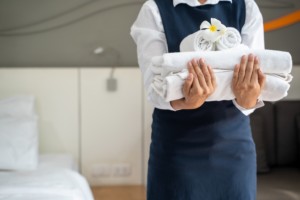Not All Employee Safety Devices Are Created Equal
Many hotels are scrambling to enact safety measures to protect their employees from potentially dangerous and uncomfortable situations. Due to the isolated nature of their work, many hotel workers are required to work alone and are often separated from their teams, subsequently these employees are vulnerable to sexual harassment and assault. As a response, major hotel brands and local municipalities have pledged to fight this issue and protect their most valuable assets, their employees. Starting with the AHLA’s 5 Star Promise in 2018, hotels are equipping their staff with safety devices/panic buttons so that they can be immediately located when in distress.
How do safety devices help to keep employees and hotels safe?
- Panic buttons dispatch emergency alerts that provide exact locations, allowing responders to reach employees within minutes.
- Staff can utilize panic buttons to summon security in the event of an altercation on the hotel’s premises.
- Employees can use panic buttons to inform management of guests who are in distress or who appear to be ill.
Hotel Panic Button Requirements
Hotel panic button legislation have been passed in many cities and states and specify requirements and deadlines for hotel panic button devices. There are a variety of panic button devices on the market that hotels can choose from, but which is right for your hotel? The type of employee safety device that is right for your hotel may depend on the hotel panic button legislation that governs your state or city, union requirements, brand standards and the specific needs of your hotel.
Cities and states have passed hotel panic button laws and have set specific guidelines as to what constitutes as a panic button device. Major hotels brands have also specified panic button requirements that their properties are required to adhere to and most of these align with legal requirements. Panic button devices should have the ability to provide precise location information down to the exact floor and room number and as the location changes, panic button devices should send updates in real time. This will allow responders to locate the distressed employee within minutes of an emergency alert.
Hotel Panic Buttons should provide:
- Reliable geolocation capability with the ability to locate employees down to room-level accuracy.
- Panic button devices should consistently work in all locations, including guest rooms, public restrooms and areas that require employees to be alone with guests.
- Panic button devices should be easily activated by a single action like a push, pull or tap. They must provide a sustained signal without delays caused by entering passwords or waiting for the system to turn on.
- Panic buttons should have the capability to dispatch responders immediately when an emergency alert is sent.
- Panic button devices should minimize unintentional activation and resist possible disabling by attackers.
What the Different Types of Panic Buttons?
Equipping employees with safety devices/panic buttons, will allow hotels to effectively respond when employees are in distress or during an emergency on the hotel’s property. There are a variety of panic button devices on the market that hotels can choose from, but which is right for your hotel? There are key advantages of panic buttons that can be beneficial for hotels but there are other devices that hotels should think twice before implementing.
Full System Panic Buttons
Full system panic buttons are location based and require the installation of location beacons in each guest room/area. Once these devices are activated, they identify the closest location beacon, and a widespread emergency alert is sent out to the dispatch center in the hotel with precise location details. One advantage of full system panic buttons is the ability to send out a silent alarm that cannot be heard by the assailant.
Key Considerations
- Panic button systems require the installation of location beacons in every room/area, plus a central reporting infrastructure.
- Panic buttons can be configured to send emergency alerts to predetermined emergency contacts or to local authorities.
- Panic buttons transmit locations down to the precise floor and room number where the distress signal originated.
- Information is sent in real time and is updated if the employee in distress changes location.
- Panic buttons would cost $10,000 for the system and $150 per month for service and support.
Mobile Panic Buttons
Mobile panic button systems require the download of a panic button app to mobile devices. When mobile panic buttons are pressed, the device sends out the employee information as well as the precise location of the emergency to hotel security personnel. These employee safety devices enable one push activation and can be configured to alert hotel security personnel or law enforcement.
Key Considerations
- Mobile panic button systems support two-way communication.
- Mobile panic buttons enable one push activation, that can be configured to alert hotel security personnel as well as local authorities.
- Mobile panic buttons utilize 4G technology to detect location and provide real time alerts.
- Devices can be installed using existing Wi-Fi- infrastructure.
- Mobile panic button systems could cost $5000 to purchase, or some options require no money at purchase but would require a small monthly fee for service.
Noise Makers
Noise makers are devices that when pressed emit an ear-piercing sound that could possibly capture the attention of those within close proximity. They produce sounds of up to 130 decibels, that is substantially loud when compared to the average speech of around 55 decibels. But noise maker devices do not have the ability to alert hotel security or to provide the location of the employee in distress and can be drowned out by television noise and cleaning equipment like vacuums.
Key Considerations
- Noise makers do not send emergency alerts or provide location details to hotel security personnel.
- Noise makers can be drowned out by television noise or cleaning equipment like vacuums.
- Building materials such as concrete floors and ceilings reduce sound by as much as 70 decibels.
- Drywall and other construction can also reduce sound by as much as 40 decimals.
- Noise makers would generally cost between $10-20 per device.
Hotels Should Say No to Noise Makers
Not all employee safety devices are created equal and not all are effective at keeping employees safe. Noise makers cost significantly less when compared to full system and mobile panic buttons, which costs between $5000 and $10,000 respectively. Noise makers generally cost between $15-20 per device, but they are not as effective at keeping employees safe as panic button devices, nor do they meet panic button legal and brand standard requirements. While noise makers may be attractive to hotels due to their low cost, their inability to send emergency alerts to security personnel or to provide precise location details should be a deterrent for hotels.




